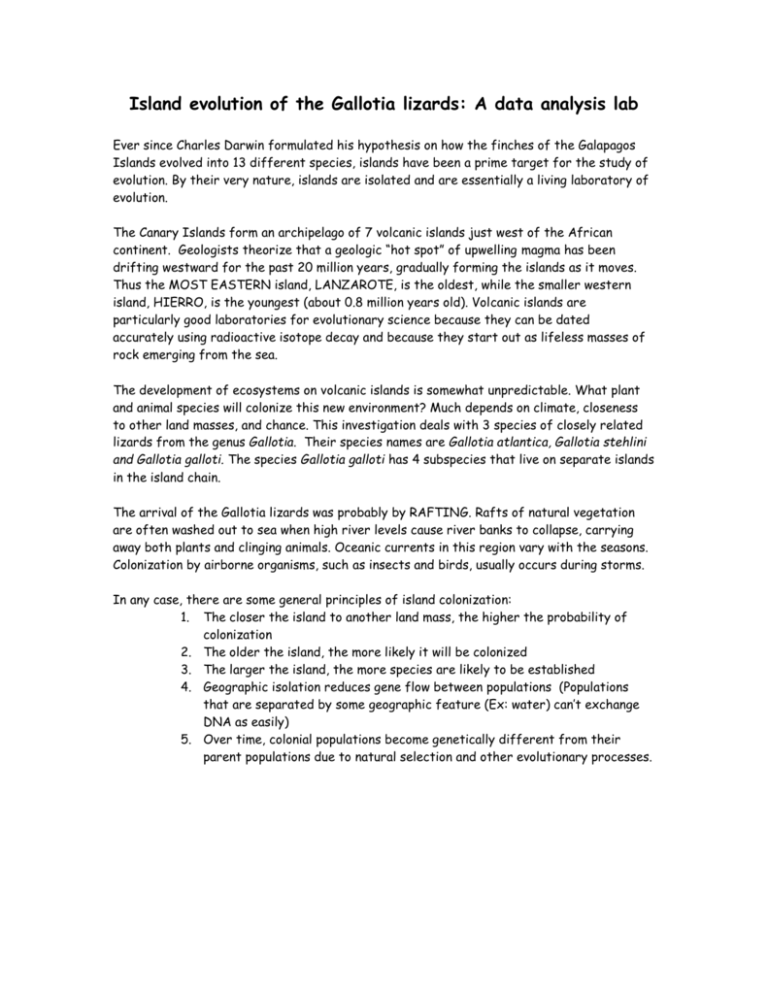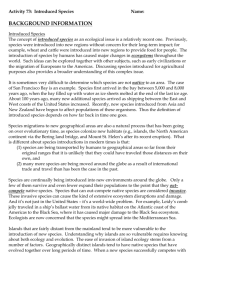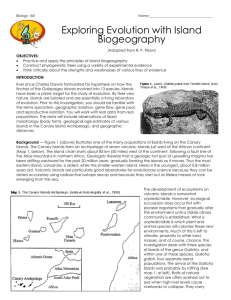Yeast Lab
advertisement

Island evolution of the Gallotia lizards: A data analysis lab Ever since Charles Darwin formulated his hypothesis on how the finches of the Galapagos Islands evolved into 13 different species, islands have been a prime target for the study of evolution. By their very nature, islands are isolated and are essentially a living laboratory of evolution. The Canary Islands form an archipelago of 7 volcanic islands just west of the African continent. Geologists theorize that a geologic “hot spot” of upwelling magma has been drifting westward for the past 20 million years, gradually forming the islands as it moves. Thus the MOST EASTERN island, LANZAROTE, is the oldest, while the smaller western island, HIERRO, is the youngest (about 0.8 million years old). Volcanic islands are particularly good laboratories for evolutionary science because they can be dated accurately using radioactive isotope decay and because they start out as lifeless masses of rock emerging from the sea. The development of ecosystems on volcanic islands is somewhat unpredictable. What plant and animal species will colonize this new environment? Much depends on climate, closeness to other land masses, and chance. This investigation deals with 3 species of closely related lizards from the genus Gallotia. Their species names are Gallotia atlantica, Gallotia stehlini and Gallotia galloti. The species Gallotia galloti has 4 subspecies that live on separate islands in the island chain. The arrival of the Gallotia lizards was probably by RAFTING. Rafts of natural vegetation are often washed out to sea when high river levels cause river banks to collapse, carrying away both plants and clinging animals. Oceanic currents in this region vary with the seasons. Colonization by airborne organisms, such as insects and birds, usually occurs during storms. In any case, there are some general principles of island colonization: 1. The closer the island to another land mass, the higher the probability of colonization 2. The older the island, the more likely it will be colonized 3. The larger the island, the more species are likely to be established 4. Geographic isolation reduces gene flow between populations (Populations that are separated by some geographic feature (Ex: water) can’t exchange DNA as easily) 5. Over time, colonial populations become genetically different from their parent populations due to natural selection and other evolutionary processes. Task: In this activity, you will be looking at data that has already been collected from other researcher’s experiments and analyzing their data to determine evolutionary relationships between six populations of lizards. This is REAL DATA from REAL POPULATIONS that live on various islands in the Canary Archipelago. Data will include: 1) lizard morphology (body form) 2) geological age estimates of the islands 3) geographic distances of the islands from the mainland 4) genetic differences (DNA sequences) between the lizard populations With this information you will create a cladogram to show how the lizards of each island are evolutionarily related. Title Name, date and name of partner Introduction/Background Information Explain the theory of evolution by natural selection. Explain how Darwin used the information from the Galapagos Tortoises to form his ideas on evolution. Explain why islands are excellent locations to study evolutionary processes. Explain how scientists define what a species is. What is a subspecies? What events can lead to the separation of one species into two? Explain what a cladogram is and how they are used to show the ancestral history of organisms. Question/Problem: What colonization pattern did the Gallotia lizards follow when populating the Canary Islands? What is the evolutionary relationship between the lizards of the Canary Islands? Hypothesis: Refer to the map of the Canary Islands on your data sheet. Based on the image, make a prediction about the colonization pattern the lizards followed using arrows to show your prediction. Clip out this map and paste it into your hypothesis section. Explain your prediction. Use that information to create a cladogram to show which lizards were most closely related to their African common ancestor. Variables: Since you will be analyzing data collected by others in this lab, you will not need a variables section. Materials: Since you will be analyzing data collected by others in this lab, you will not need a materials section. Experimental Design/Procedure: Look at the data sheet that is included for this lab. Use the information presented within these data sets to determine a procedure that the scientists may have used to collect this data. List their procedures in this section. Results/Data: Clip out figures 2-5 that are given to you on the data sheet and paste them into your data section along with any analysis sections included in the data sheet. Below each graph, draw a cladogram that shows your prediction of the evolutionary relationship of the six lizard populations based on the data in each figure. Include a final cladogram that combines the 4 sources of data into one representative cladogram. Include a description of the thought process you went through to create your final cladogram. Conclusions: 1. After looking at your results do you support or reject your original hypothesis? Use your data to explain your reasoning. 2. How did multiple forms of data help to generate your results (as opposed to one set of data) ? 3. Is your conclusion the definitive answer to the question presented at the beginning of the lab? Explain. 4. Refer to the general lab report template and the questions that accompany the data to complete the conclusion. Lab based off of an activity from: ISLAND BIOGEOGRAPHY AND EVOLUTION: SOLVING A PHYLOGENETIC PUZZLE USING MOLECULAR GENETICS by RP Filson www.ucmp.berkeley.edu/fosrec/Filson.html







